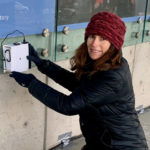“Climate change, population growth, water diversions — all those are acting together to cause a big decline in the level of the Salt Lake,” says Kerry Kelly, associate professor of chemical engineering at the University of Utah. “And that’s leading to big air quality problems here.” In this video, she talks about how the dust left behind by the drying lake now kicks up on a regular basis, irritating eyes, noses and mouths, and making it tougher for people to breathe, especially those with asthma or other respiratory conditions. One recommendation that Kelly made to keep the air cleaner — restrictions on wood-burning fireplaces — was met with severe backlash. Kelly is now the co-founder of Tellus Networked Air Quality Sensors, which is developing a low-cost air quality sensor to measure air pollution from the drying lake. The dust contains arsenic, lead and mercury, among other toxins.
Kelly is a recipient of The Story Exchange’s 2022 Women In Science Incentive Prize.
*This video is a 2023 winner of SABEW’s Best in Business awards: “The Story Exchange laid out the story in less than eight minutes in a clear, succinct and engaging way… a splendid job of reporting and explaining an important and interesting story.”


